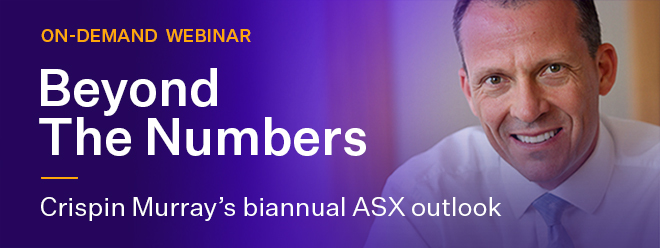
Mainstream Online Web Portal
LoginInvestors can view their accounts online via a secure web portal. After registering, you can access your account balances, periodical statements, tax statements, transaction histories and distribution statements / details.
Advisers will also have access to view their clients’ accounts online via the secure web portal.
Jim Taylor: What’s driving ASX stocks this week?
Here are the main factors driving the ASX this week according to portfolio manager JIM TAYLOR. Reported by investment specialist Chris Adams
- Find out about Pendal Focus Australian Share Fund
- On-demand: tune into Crispin Murray’s bi-annual Beyond the Numbers webinar
EQUITY and bond returns were strong last week, with the local market leading the charge.
The S&P/ASX 300 gained 1.97%, while the S&P 500 rose 1.36%.
Commodities had it tough, with the oil price falling through US$80 for the first time in four months.
This provides some comfort around the near-term direction for headline inflation, which flows through to interest rates, policy, the dollar, and the performance of mega-cap growth stocks.
The global central bank easing cycle was kicked further into gear, with the Bank of Canada and European Central Bank (ECB) both cutting rates.
With that said, the ECB cut felt hawkish, with President Lagarde at pains to suggest the scope and pace of the rate cutting cycle from here is far from certain.
Economic data has been plentiful but lacking in real substance ahead of the US CPI this week, though Friday’s blow-out US jobs data print – which drove US bond yields up 15 basis points (bps) – pointed to a resilient labour market which continues to be a unique feature of this cycle.
Another feature is the bifurcated spending patterns of young versus older consumers, which is making the central banks’ job of navigating policy a whole lot harder.
The market has been oscillating between “bad news is good news” and fears that major economies are beginning to show signs of consumer stress based on the maxim that “monetary changes have their effect only after a considerable lag and over a long period”.
It seems the market is okay with bad news provided that news is not too bad.
Australia macro and policy
Reserve Bank of Australia (RBA)
RBA Governor Bullock delivered testimony to the Senate, which struck a government-friendly tone.
She noted that that the RBA’s estimate of the non-accelerating inflation rate of unemployment (NAIRU) was currently 4.3%, only 20bps above the current unemployment rate of 4.1%.
This was caveated by significant uncertainties around the estimate.
The RBA expects new energy rebates to reduce headline inflation by about 50bps in the next financial year, but that it won’t have a material impact on underlying trimmed-mean inflation or boost consumer spending given the relatively small size.
Bullock also pointed out that the RBA thinks monetary policy is taking about 18 months to flow through, suggesting in “a general sense that there is about 50bps of policy tightening to come”.
Q1 GDP
Economic growth was subdued in the first quarter, rising 0.1% quarter-on-quarter and 1.1% year-on-year. It is running at 0.9% on a six-month annualised basis.
This reflects a broader slowdown in the economy as the 2023 softness in households – in response to higher taxes and interest rates crimping real incomes – has expanded to public and private investment.
Both declined in Q1 and saw a smaller contribution to annual growth.
Public investment does remain at high levels, despite falling for the second consecutive quarter.
State and Federal budgets suggest that the spending pipeline peaks in FY25, as some major transport projects also reach completion.
Dwelling investment fell 0.5% to be 3.4% lower year-on-year. This is expected to continue falling, with detached housing projects falling steeply as the Homebuilder Subsidy boost falls away.
Other data
The Fair Work Commission raised Award and Minimum wages by 3.75% from 1 July 2024, which was largely as expected and below the 5.8% increase in 2023.
Dwelling prices across the eight-city average rose 0.8% month-on-month in May, up from 0.5% in April, representing the largest monthly gain since October 2023.
According to CoreLogic, national rents rose 0.7% month-on-month in May, down from 0.8% in April, representing the lowest monthly gain since December.
The slowdown is probably attributable to lower net migration and the impact of affordability on rental patterns, they noted.
Retail volumes have fallen below the pre-Covid trendline, though price remains well above it.
Conditions in Victoria look particularly weak, with anecdotes that events such as the Australian Open, the Grand Prix and Taylor Swift concert have masked underlying softness.
There are suggestions that changes to state taxes are taking a toll on sentiment.

Find out about
Crispin Murray’s Pendal Focus Australian Share Fund
US macro and policy
Non-farm payrolls rose 272k in May, versus 180k consensus expectations and 175k in April.
The three-month moving average is running at 249k per month, only modestly down from 261k per month in the preceding three-month period.
There was a strong skew to the “experience” pasts of the economy, where spending remains strong – potentially supported by older cohorts – with leisure and hospitality adding 42k jobs versus 26K in the good-producing segment of the economy.
Government jobs also strengthened following a weak April.
Average hourly earnings rose 0.4% versus the 0.3% expected and 0.2% seen in April. It is running at 4.1% year-on-year, which is still too high for the Federal Reserve’s comfort.
Unemployment is running at 4.0% versus the 3.9% expected. This is the first time at 4% in two years.
April JOLTS job opening came in at 8.06 million versus the 8.35 million expected and the 8.25 million seen in March.
This means the job-opening-to-unemployed ratio is at 1.24 – the lowest since January 2020 and down from 2.0 when rates began rising in March 2022.
The Quits rate – seen as a lead indicator for wage pressures – held steady at 2.2% and continues to suggest the employment cost index (ECI) should moderate over the next six months.
The ISM Manufacturing Index fell from 49.2 in April to 48.7 in May, driven by weakness in the new orders sub-index, which suggests ongoing weakness in manufacturing.
The ISM Service Index hit 53.8, up from 49.4 in the previous month and ahead of consensus sat 51.0.
While strong, this index has been in a range and has not been a strong indicator of spending habits.
Central banks
The Bank of Canada became the first G7 central bank to cut rates, shifting down 25bps to 4.75%.
The Chair left the door open to further cuts, saying they are confident inflation is heading to the 2% target.
The ECB reduced rates from 4% to 3.75%, however, the accompanying commentary was clearly designed to discourage expectations of a near-term continuation of cuts.
The rate-setting committee “is not pre-committing to a particular rate path” and rates are “not close to neutral”, according to accompanying statements.
This was reinforced by April core inflation in the EU ticking up from 2.7% to 2.9%. ECB President Lagarde noted a “strong likelihood” of further cuts in the months ahead, but stressed that “the speed of travel and time it will take” are very uncertain.
Markets
We observe that there has been a significant increase in demand for upside exposure among professional investors in the past week.
The funding spreads – the cost to fund a levered long position in futures, swaps or options –jumped to 70bps, the highest level since January 2018.
Most sectors in the S&P/ASX 300 gained for the week, led by Financials (3.88) and Consumer Staples (3.40%).
Information Technology fell 0.67%, while Materials was off 0.50% on some weakness in the resource sub-sector.
About Jim Taylor and Pendal Focus Australian Share Fund
Drawing on more than 25 years of experience investing in top-performing Australian companies and a background in accounting, Jim manages our Long/Short Fund and co-manages our Imputation Fund. He is a Chartered Accountant with membership of the Australian Institute of Chartered Accountants.
Pendal Focus Australian Share Fund is managed by Crispin Murray. The fund has beaten its benchmark in 14 years of its 18-year history (after fees), across a range of market conditions. Find out more about Pendal Focus Australian Share Fund here.
Pendal is an independent, global investment management business focused on delivering superior investment returns for our clients through active management.
This information has been prepared by Pendal Fund Services Limited (PFSL) ABN 13 161 249 332, AFSL No 431426 and is current at June 11, 2024.
PFSL is the responsible entity and issuer of units in the Pendal Focus Australian Share Fund (Fund) ARSN: 113 232 812. A product disclosure statement (PDS) is available for the Fund and can be obtained by calling 1300 346 821 or visiting www.pendalgroup.com. The Target Market Determination (TMD) for the Fund is available at www.pendalgroup.com/ddo. You should obtain and consider the PDS and the TMD before deciding whether to acquire, continue to hold or dispose of units in the Fund.
An investment in the Fund or any of the funds referred to in this web page is subject to investment risk, including possible delays in repayment of withdrawal proceeds and loss of income and principal invested.
This information is for general purposes only, should not be considered as a comprehensive statement on any matter and should not be relied upon as such. It has been prepared without taking into account any recipient’s personal objectives, financial situation or needs. Because of this, recipients should, before acting on this information, consider its appropriateness having regard to their individual objectives, financial situation and needs. This information is not to be regarded as a securities recommendation.
The information may contain material provided by third parties, is given in good faith and has been derived from sources believed to be accurate as at its issue date. While such material is published with necessary permission, and while all reasonable care has been taken to ensure that the information is complete and correct, to the maximum extent permitted by law neither PFSL nor any company in the Pendal group accepts any responsibility or liability for the accuracy or completeness of this information.
Performance figures are calculated in accordance with the Financial Services Council (FSC) standards. Performance data (post-fee) assumes reinvestment of distributions and is calculated using exit prices, net of management costs. Performance data (pre-fee) is calculated by adding back management costs to the post-fee performance. Past performance is not a reliable indicator of future performance.
Any projections are predictive only and should not be relied upon when making an investment decision or recommendation. Whilst we have used every effort to ensure that the assumptions on which the projections are based are reasonable, the projections may be based on incorrect assumptions or may not take into account known or unknown risks and uncertainties. The actual results may differ materially from these projections.
For more information, please call Customer Relations on 1300 346 821 8am to 6pm (Sydney time) or visit our website www.pendalgroup.com

